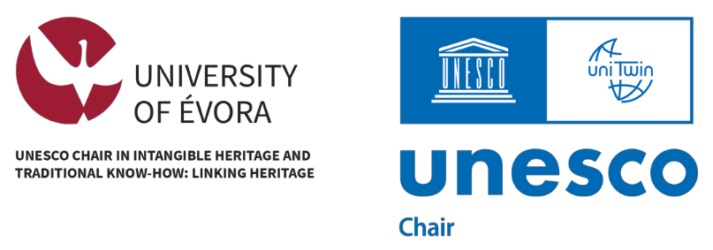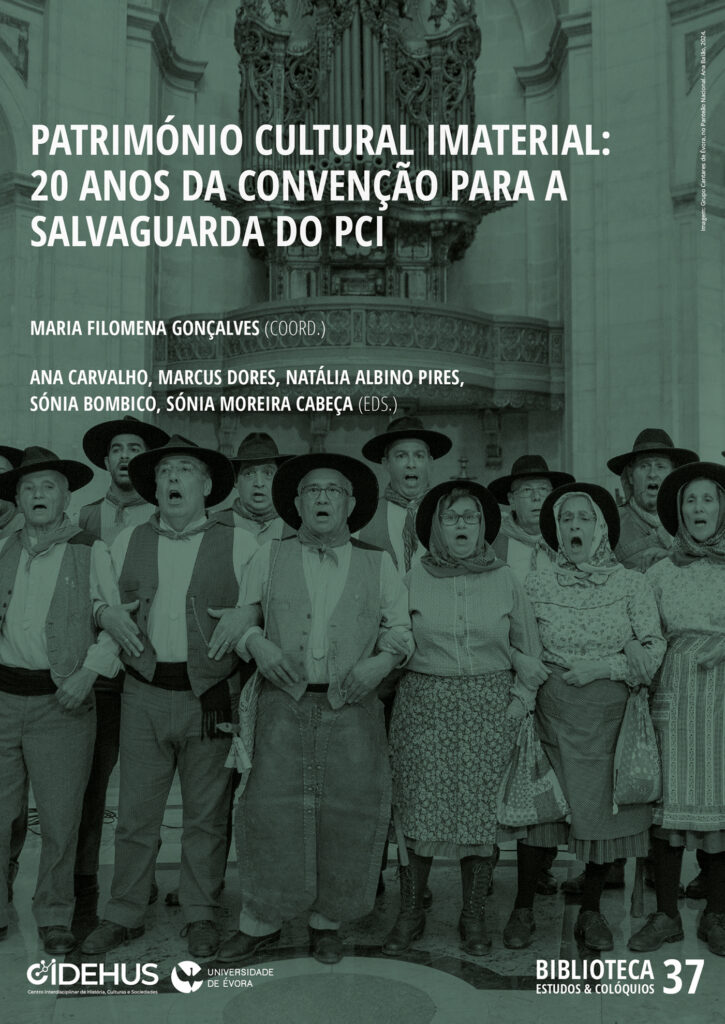
Património Cultural Imaterial: 20 anos da Convenção para a Salvaguarda do PCI
Os trabalhos reunidos neste volume versam sobre vários dos aspetos relativos ao PCI e à Convenção para a Salvaguarda do Património Cultural Imaterial, contribuindo para um «estado da arte»: o conceito de PCI; a situação de alguns inventários; a reconstrução da memória; o património material e a imaterialidade; o património linguístico e a literatura oral; as tradições e manifestações religiosas; o património alimentar; os programas e as ações em torno do PCI; educação patrimonial e a coesão social; as questões de género e o PCI; os estudos de caso; a diversidade das expressões de PCI; as paisagens culturais; o PCI, o turismo, e a sustentabilidade.
Gonçalves, M. F., Carvalho, A., Dores, M., Pires, N. A., Bombico, S., & Cabeça, S. M. (éds.). (2025). Património Cultural Imaterial: 20 anos da Convenção para a Salvaguarda do PCI (1‑). Publicações do CIDEHUS. https://doi.org/10.4000/1441z
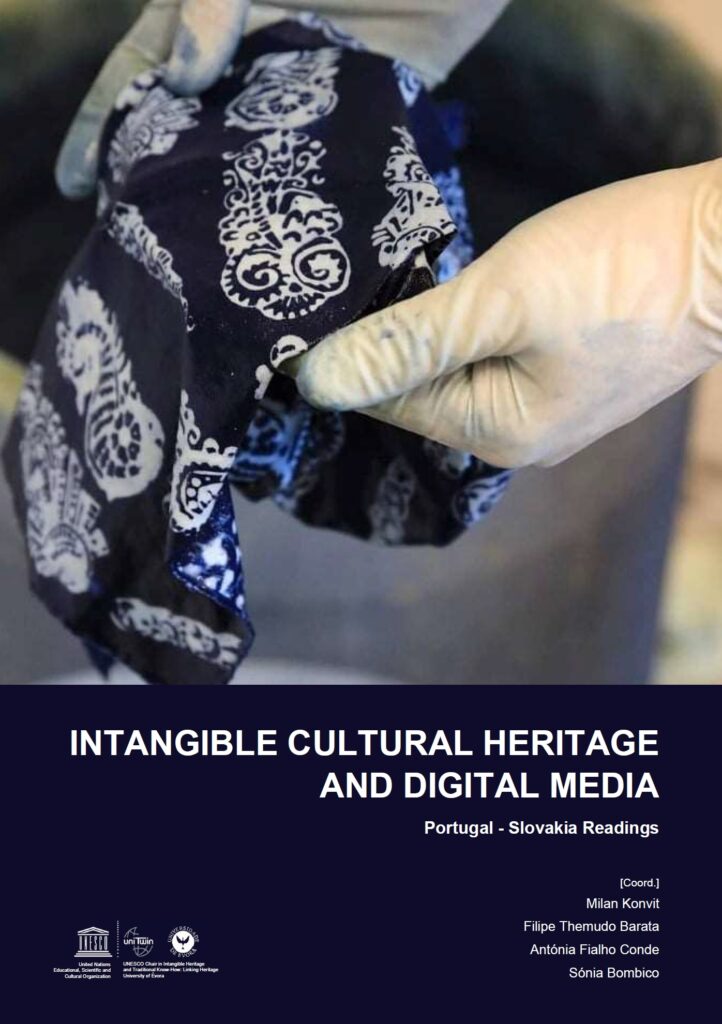
Intangible Cultural Heritage and Digital Media: Portugal – Slovakia Readings
The present publication results from the work developed within the BDIAS project – Capturing mechanisms and presentation of intangible cultural heritage with an emphasis on new media use. The main objective of the project was the discussion on methodologies for safeguarding and enhancing intangible cultural heritage and the reflection on the role that digital media can play in the processes of preservation of ICH (Intangible Cultural Heritage) and in the transmission of traditional know-how.
Konvit, M.; Barata, F. T.; Conde, A. F. e Bombico, S. (Coord.). (2022) – Intangible Cultural Heritage and Digital Media: Portugal – Slovakia Readings, University of Évora, UNESCO Chair in Intangible Heritage and Traditional Know – How: Linking Heritage, pp.153. ISBN 978-972-778-269-7 (e-book)
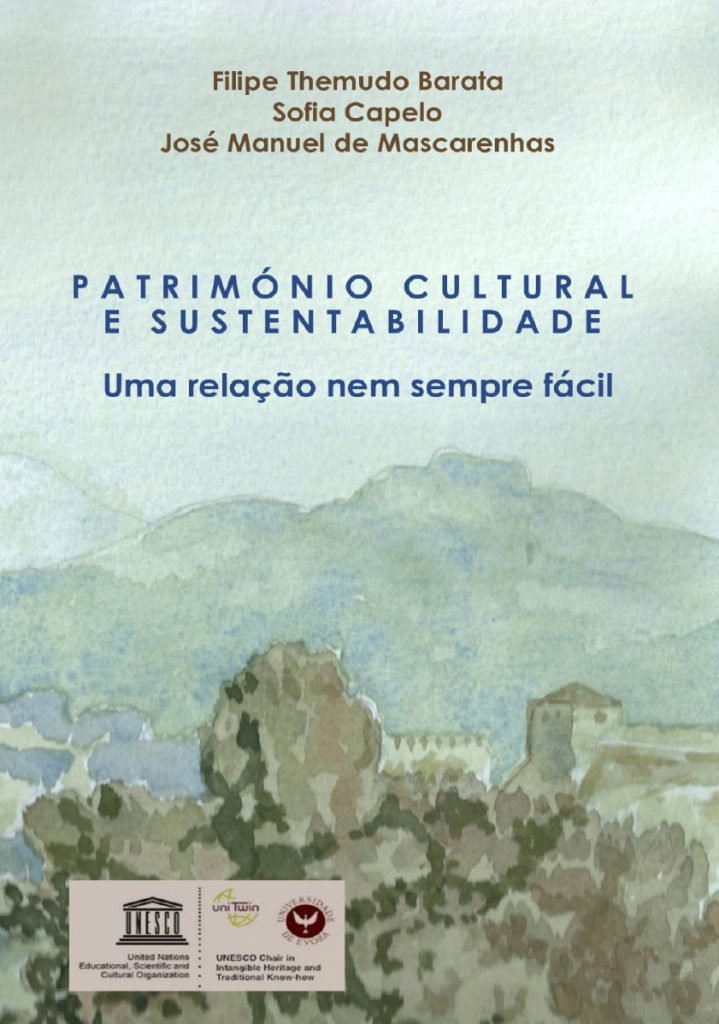
Património Cultural e Sustentabilidade. Uma relação nem sempre fácil
Cultural heritage and its sustainability are much discussed. Actually, this theme, although it seems easy to deal with, almost obvious we would say, has a complexity, which we intend to present here in a way understandable to all. The subtitle points to an essential issue, that is the relationships, sometimes conflicting, sometimes cooperating, between sustainability policies and conservation, protection and enhancement of the cultural heritage. The authors hope that the book will be useful for all those who are faced with the problems of knowing what to do with their cultural heritage, and there are many. Initially, the idea was to support students who want to consult it, but then there was also the wish to help municipal and central government officials, cultural and economic experts and researchers to find some answers.
Barata, F. T., Capelo, S., & Mascarenhas, J. (2021). Património Cultural e Sustentabilidade. Uma relação nem sempre fácil. (F. T. Barata, S. Capelo, & J. M. Mascarenhas, Edits.) Évora: Cátedra UNESCO da Universidade de Évora em “Património Imaterial e Saber Fazer Tradicional”. ISBN: 978-972-778-203-1.

Drawing Heritage(s)
This publication is conceptualized as interdisciplinary, with a goal to ponder drawing in a joint perspective of heritage and landscape. Marrying perspectives on methodological and theoretical aspects of this theme, the book offers contributions from established and emerging academics, as well as artists and professionals of different backgrounds. Its main goal is to explore drawing not only in terms of observing or gazing, but rather in ways of knowing, as a tool that, implemented methodologically, could support and enhance these complex and continually evolving areas of study.
Nevena Tatovic, Shajjad Hossain (editors). 2021. Drawing Heritage(s). Évora: UNESCO Chair in Intangible Heritage and Traditional Know-How, Universidade de Évora. ISBN: 978-972-778-198-2.
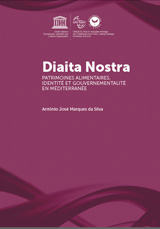
Diaita Nostra – Patrimoines alimentaires, identité et gouvernementalité en Méditerranée
Cet essai, au croisement des sciences historiques et des sciences sociales, vise à comprendre comment la communauté épistémique, qui a oeuvré en faveur du classement de la diète méditerranéenne par l’UNESCO, mobilise aujourd’hui les patrimoines alimentaires des pays du bassin en tant qu’instruments de gouvernementalité dans des domaines de gouvernance très variés.
L’auteur plaide ici en faveur de l’idée que le collectif méditerranéen transnational fondé sur un héritage culinaire partagé est aujourd’hui avant tout un projet politique qui légitime l’existence de la société savante, cosmopolite et hétérogène, qui a pris en charge sa sauvegarde. En effet, l’UNESCO a fait bien plus que promouvoir l’identité méditerranéenne. En inscrivant ce modèle nutritionnel sur la liste du patrimoine culturel immatériel de l’humanité, cette organisation onusienne a objectivé l’invention de « la » communauté méditerranéenne.
Le but de cette réflexion est de rompre avec le nationalisme méthodologique à la base du paradigme qui rassemble cette communauté épistémique et d’adopter une approche plus « émique » afin de repenser l’usage gouvernemental actuel des patrimoines alimentaires de ces communautés, en valorisant plus que d’ordinaire le point de vue de leurs membres, et pas seulement celui du collectif « pro-Méditerranée » qui s’est chargé de les représenter.
La perspective de l’historien sera également prise en compte. L’enjeu d’une telle démarche est de promouvoir le dialogue et la compréhension mutuelle entre communautés méditerranéennes, permettant par la même occasion de réconcilier la praxis dans les arènes de l’UNESCO avec la doctrine patrimoniale actuelle et la mission constitutionnelle de cette institution.
Download HERE
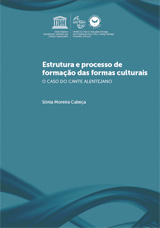
Estrutura e processo de formação das formas culturais – O caso do Cante Alentejano
Any system of practices that can be individualized and distinguished by its practitioners can be characterized through the form it assumes and the set of its attributes. Such form corresponds to an analytical framework that has its equivalent in the real world of the actors and in the discourses they construct with regard to their practices, from which emerges a set of rules. Therefore, the form is not only an external methodological construction for the description of the system and the conditions on which it is based, but also a dynamic reality that produces cultural identities. We intend to replace a rather imprecise notion of “cultural form” by a structured concept that defines it as a reference system which members of a given culture share and which guides and regulates the cultural processes of production and reproduction. This reference system contains a structuring element, a normative system, and a social dynamic. In order to reach this conceptualization, the concept had to be applied to an empirical object of study, which we have done by analyzing the Cante Alentejano – a traditional way of singing from the Alentejo region – as a cultural form.
Download HERE
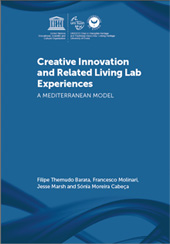
Creative Innovation and Related Living Lab Experiences: A Mediterranean Model
The CreativeMED project and its overall assessment are at the centre of this book that its editors consider to be of particular interest, not only as an account of the achieved results, but also because it had been granted by the European Union with the main purpose of capitalising on the outcomes of the work previously developed by the MED programme.
In addition to that, the editors are well aware of the need to stimulate the debate and reflection on the so-called ‘Smart Specialisation’ and to participate in a broader discussion of a concept that challenges cities and regions – or rather territories – to define their priorities and find ways and means to implement them. (…)
Download HERE
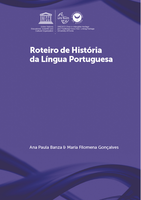
Roteiro de História da Língua Portuguesa
Using as inspiration the nautical terminology, this Guide shows routes, indicates stages, and highlights the main changes undergone through the centuries by the Portuguese language. Eventually, it will trigger the autonomous learning of less-explored or not-yet-explored topics related to the history of the Portuguese language.
“[…] the history of the Portuguese language, as patrimony, would thus appeal to a wider public, including students of Linguistics, but also professionals and researches hailing from different areas—e.g., historians, sociologists, anthropologists, journalists, professionals in the field of culture, and diverse scientists—as well as those who are simply curious about the history of one of the most spoken languages in the world.”
Download HERE
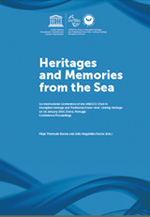
Heritages and Memories from the Sea
The proceedings of the international conference “Heritages and Memories from the Sea”, organised by the UNESCO Chair in Intangible Heritage and Traditional Know-how: Linking Heritage in Évora from 14–16 January 2015, are presently available in an electronic edition.
The subdivision into five broad subject areas demonstrates the diversity of issues related to intangible heritage:
1. Uncovering heritages and memories
2. The floating memory of rivers and seas
3. Anthropological approaches to heritage and memory
4. Otherness and closeness in cultural heritage
5. On the relationship between material and immaterial heritage
Download HERE
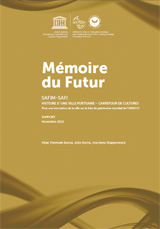
Mémoire du Futur – SAFIM-SAFI: histoire d’une ville portuaire – carrefour de cultures
«Ce rapport est le résultat du travail commun et collaboratif entre deux groupes d’enseignants, un de l’Université Cadi Ayyad de Marrakech et un autre de l’Université d’Évora. Tout au long des années cette coopération a abouti à plusieurs conclusions, dont une des plus intéressantes c’est le terrain à exploiter : la ville de Safi.
Là, on trouve un patrimoine d’origine portugaise à côté d’un autre bien marocain. Cependant, dans la ville, on comprend comme les gens vivent bien avec cette diversité, ce qui a contribué à bâtir une identité spéciale. D’une autre part, c’est assez claire la richesse de tout ce patrimoine : la musique traditionnelle, les pratiques liées à la mer et l’incroyable école de céramique de Safi se mélangent avec les châteaux et les murailles d’origine portugaise et les anciennes structures islamiques, comme le minaret almohade de l’ancienne mosquée de Safi. (…)» [Présentation des coordinateurs].
Download here


